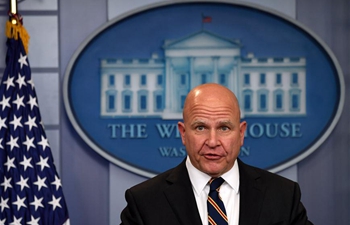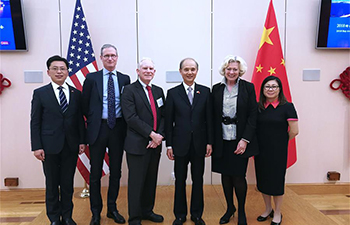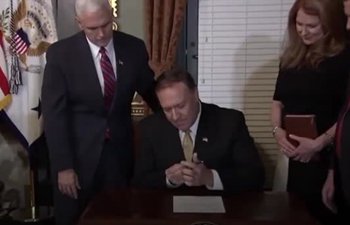WASHINGTON, March 22 (Xinhua) -- Despite strong warnings from business groups and trade experts, U.S. President Donald Trump on Thursday signed a memorandum that could impose tariffs on up to 60 billion U.S. dollars of imports from China, in a unilateral move that triggered market selloff.
The move prompted the biggest percentage plunges in Wall Street's three major stock indexes in six weeks as investors were agitated by the scale of U.S. tariffs and possible impact on global trade.
The Chinese Embassy in the United States, in response, said "It is a typical unilateral trade protectionist action. China is strongly disappointed and firmly opposes such an action."
"The actions undertaken by the U.S. are self-defeating. They will directly harm the interests of U.S. consumers, companies, and financial markets. They also jeopardize international trade order and world economic stability," the Chinese embassy said in a statement.
According to the presidential memorandum, Trump has directed U.S. Trade Representative Robert Lighthizer to publish a list of proposed Chinese goods that could be subject to tariffs in 15 days, while the U.S. Treasury Department will have 60 days to propose restrictions on Chinese investment in the United States.
The tariffs "could be about 60 billion" dollars, Trump said at the White House before signing the memorandum. But a senior White House official told reporters earlier in the day that the number would be close to 50 billion dollars.
So far, there was no official explanation of the difference between the numbers provided by the White House official in the briefing and Trump's 60 billion.
The memorandum is based on a so-called Section 301 investigation into alleged Chinese intellectual property and technology transfer practices, launched by the Trump administration in August 2017.
Responding to media reports that Washington will soon release results of the investigation, China's Ministry of Commerce said on Thursday that China will "take all necessary measures" to defend its rights and interests.
"China has made clear its position several times that it stands firmly against such unilateral and trade protectionist practices from the U.S. side," an official with the Ministry of Commerce said.
Section 301, once heavily used in the 1980s and the early 1990s, allows the U.S. president to unilaterally impose tariffs or other trade restrictions on foreign countries. But the United States has rarely used the outdated trade tool since the World Trade Organization (WTO) came into being in 1995.
"It became no longer necessary really for the United States that they have to use that law, because now we have an effective dispute settlement system under the WTO," said Chad Bown, a trade expert and senior fellow at the Washington D.C.-based Peterson Institute for International Economics (PIIE).
The memorandum follows Trump's recent tariff plan on steel and aluminum imports and January's tariffs levied on imported solar panels and washing machines. These unilateral moves have prompted strong opposition and warnings from business groups around the world.
In a letter to Trump on Sunday, 45 U.S. trade associations, representing retail, technology, agriculture and other consumer-product industries, urged the administration not to move forward its tariff plan on Chinese imports, as it would hurt U.S. consumers and companies.
A group of 25 major U.S. retail companies, including Walmart, Costco and Best Buy, also warned on Monday that any additional broad-based tariff would worsen U.S. inequity and "punish American working families" with higher prices on household basics like clothing, shoes and electronics.
If the Trump administration imposes a 25-percent tariff on information and communications technology imports from China, it would cost the U.S. economy 332 billion dollars over the next 10 years, according to a report recently released by the Information Technology and Innovation Foundation, a U.S. technology policy think tank.
"Simply put, tariffs are damaging taxes on American consumers," said Thomas J. Donohue, president and CEO of the U.S. Chamber of Commerce, warning the Trump administration's tariff plan could lead to "a destructive trade war" with serious consequences for U.S. economic growth and job creation.
"Tariffs of $30 billion a year would wipe out over a third of the savings American families received from the doubling of the standard deduction in tax reform. If the tariffs reach $60 billion, which has been rumored, the impact would be even more devastating," Donohue said.
While it remains unclear about the scope and scale of Trump's tariff plan on China, "certainly it's very clear that tariffs will increase the cost of goods for Americans, both American consumers and American companies," Henry Levine, senior advisor at leading U.S. consulting firm Albright Stonebridge Group, told Xinhua.
Meanwhile, it will have a negative effect on the stock markets because "investors will worry that we're heading for a trade war and worry about the effect," said Levine, who has worked at the U.S. Department of State and Department of Commerce, adding it also depends on how China reacts.
"If China retaliates on a very large scale, then the impact on the American economy is going to be much greater than if they don't," he said.
U.S. stocks tumbled even prior to Trump's announcement of the tariffs plan which spurred fear of an escalating trade war. The benchmark S&P 500 Index slumped the most since early February and the Dow Jones Industrial Average dropped more than 700 points.













